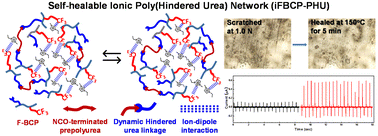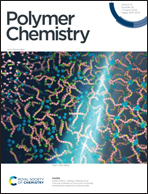Self-healable triboelectric nanogenerators based on ionic poly(hindered urea) network materials cross-linked with fluorinated block copolymers†
Abstract
The triboelectric nanogenerator (TENG) has been anticipated as a cost-effective energy harvesting device that can convert mechanical energies to electricity. Further to the modification of structural and functional properties of triboelectric materials, an integration of self-healability has been explored as an advanced platform for the development of multifunctional TENGs due to their improved lifetime and function. In this study, we demonstrate the versatility of a reactive block copolymer approach that allows for the fabrication of ionic poly(hindered urea)-based covalent adaptive networks having pendant fluorinated species formulated with ionic liquid as effective self-healable triboelectric materials. The reactive block copolymer is well-defined, designed with a dynamic t-butylamino block for self-healability and a dielectric fluorinated block for improved triboelectric output, and used as a multifunctional crosslinker. Fabricated by two-step polyaddition in combination with physical blending with ionic liquid, the formed ionic fluorinated poly(hindered urea) networks crosslinked with reactive block copolymer have enhanced TENG outputs while retaining good self-healing and mechanical strength. Promisingly, their recovery of triboelectric performance is greater than 90% upon the repair of damaged surfaces. This work demonstrates the versatility of the new reactive block copolymer approach to fabricate dynamic PHU networks exhibiting desired properties useful for advanced self-healable-TENG-based energy harvesting devices and electronics.



 Please wait while we load your content...
Please wait while we load your content...